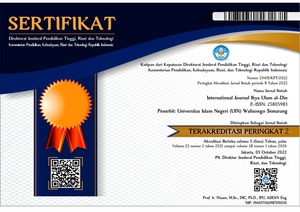Moslem Sculptor (Negotiation of Sculptor at Prumpung Magelang Towards The Doctrine of Sculpting’s Prohibition on Islam)
DOI:
https://doi.org/10.21580/ihya.23.1.7863Keywords:
Orthodoxy, Moslem Sculptor, Negotiation and ReceptionAbstract
Normatively, Islamic doctrine prohibits figurative art in the form of sculpture or painting. The prohibition actually comes not from the Koran but from various narrations of the Prophet's hadith. However, it has been transformed into an orthodox doctrine for its adherents. This research does not aim to find the essential meaning of the hadith text which prohibits figurative art, but to find out how the Moslem sculptors, who live at Prumpung Magelang area, respond and negotiate toward it, so in the end they decided to compromise with their profession as a sculptor. Reception theory is used in this study to map the creative reasoning model of Moslem sculptors when negotiating with texts. Through the reception approach, and field data collection through in-depth interviews with several informants consisting of Muslim sculptors at Prumpung Magelang, this research concludes that the existence of the statue, according to the perspective of the Moslem sculptors at Prumpung Magelang is merely works of art so that in existence there are no theological problems.
Downloads
References
al-‘Ainy Al-Hanafiy, B. n.d.. ‘Umdatul Qariy Syarkh Shahih Bukhariy (0.1; pp. XVII–159). Program Maktabah Syumila NU.
al-‘Ainy Al-Hanafiy, B. n.d.. ‘Umdatul Qariy Syarkh Shahih Bukhariy (0.1; pp. XVII–159). Program Maktabah Syumila NU.
al- Kalbī, H. I. M. ibn as-S. 1995. Kitāb al- Aṣnām. Darul Kutub al-Misriyyah.
an-Nawawi, A. Z. Y. ibn S. ibn M. n.d. al-Minhaj Syarkhu Shahih Muslim ibn al-Hajjaj (0.1; pp. 81–91). Maktabah Syumila NU.
Aṣ-Ṣābūnī, M. ‘Ali. (1981). Rawāi’ul Bayān. Maktabah al-Ghazāli.
asy-Syarqawi, M. A. H., & & Ath-Thahlawi, M. R. 2009. Ka’bah; Rahasia Kiblat Dunia (K. Junaidi, Luqman & Fath (ed.)). MIZAN.
Athamina, K. 2004. Abraham in Islamic perspective reflections on the development of monotheism in pre-Islamic Arabia. Islam - Zeitschrift Fur Geschichte Und Kultur Des Islamischen Orients, 81(2), 184–205. https://doi.org/10.1515/islm.2004.81.2.184
Az-Zamakhsyarī, A. al-Q. M. bin U. 1998. Tafsīr al-Kasyāf (- (ed.)). Maktabah al-‘Abikan.
Caviness, M. H. n.d. Iconoclasme et Iconophobie; Quatre Etudes De Cas Historiques. Diogene-Presses Universitaires de France. https://www.cairn.inforevue-diogene-2002-3-page-119.htm
Donner, F. M., & Hawting, G. R. 2001. The Idea of Idolatry and the Emergence of Islam: From Polemic to History. Journal of the American Oriental Society, 121(2), 336. https://doi.org/10.2307/606608
Florella, S. 2007. The word ṣlm/ṣnm and some words for “statue, idol” in Arabian and other Semiticlanguages. Proceedings of the Seminar for Arabian Studies, 37.
Hardiman, F. B. 2015. Seni Memahami: Hermeneutika dari Schleiermacher sampai Derrida. Yogyakarta. PT Kanisius.
Iser, W. 1987. The Act of Reading: A Theory Of Aesthetic Response (- (ed.)). The Johns Hopkins University Press.
Isnaeni, A. 2014. Historisitas Hadis Dalam Kacamata M Mustofa Azami. Jurnal EPISTEME, 9(2).
Kartodirjo. 1983. Elit Dalam Perspektif Sejarah (Kartodirjo (ed.)). LP3ES.
Komaroff, L., & Allen, T. 1991. Five Essays on Islamic Art. Journal of the American Oriental Society, 111(3), 611. https://doi.org/10.2307/604298
May, N. N. 2012. Iconoclasm and text destruction in the ancient Near East and beyond. In Iconoclasm and Text Destruction in the Ancient Near East and Beyond (Issue 8). https://oi.uchicago.edu/pdf/10_11_Iconoclasm.pdf
Miftah, F. 2005. Perilaku Sosial Politik Kyai Di Tengah Masyarkat Transisi; Kasus Di Wilayah Cirebon Dan Bandung. Jurnal MINBAR, XXI(2).
Mustofa, A. 2021. PATUNG ANTARA DOKTRIN DAN TRADISI (Resepsi Pemahat di Prumpung Magelang Terhadap Hadis Pelarangan Patung). Universitas Islam Negeri Sunan Kalijaga Yogyakarta.
Pradopo, R. D. 2007. Beberapa Teori Sastra; Metode Kritik dan Penerapannya, (- (ed.)). Pustaka Pelajar.
Ratna, N. K. n.d.-a. Estetika Sastra dan Budaya (- (ed.)). Pustaka Pelajar.
Ratna, N. K. n.d.-b. Teori, Metode Dan Teknik Penelitian Sasatra: Dari Strukturalisme Hingga Post Strukturalisme-Perspektif Wacana Naratif (- (ed.)). Pustaka Pelajar.
Rofiq, A. 2014. The Reception of the Qur’an in Indonesia: A Case Study of the Place of the Qur’an in a Non-Arabic Speaking Community. The Temple University Graduate USA.
Soganci, Ismail, O. 2004. Islamic Aniconism: Making Sense of a Messy Literature. Marilyn Zurmuehlen Working Papers in Art Education, 1. https://doi.org/10.17077/2326-7070.1376
Soidah, K. 2014. Teologi Pemahat Patung; Pemahaman Teologi Pemahat Patung Tentang Ke Esaan Allah di Dusun Jatisumber Desa Watesumpak Kecamatan Trowulan. UIN Sunan Ampel Surabaya.
Spraggon, J. 2012. Puritan Iconoclasm during the English Civil War. In Puritan Iconoclasm during the English Civil War. https://doi.org/10.1017/upo9781846151408
SUnyoto, A. 2012. Atlas Wali Songo. Mizan Media Utama.
Walter, J, O. 2013. Kelisanan Dan Keaksaraan (I. Rika (ed.)). Gading Publishing.
Downloads
Published
How to Cite
Issue
Section
License
By submitting an article to the journal, the author(s) agree to transfer the published article's copyright to the journal, which will act as the publisher. This means the journal will have the right to publish the article in various forms, including reprints. The journal will maintain the publishing rights to the published articles.
This work is licensed under Creative Commons Attribution-ShareAlike 4.0 International License.
In line with the license, authors and third parties (readers, researchers, and others) are allowed to share and adapt the material. In addition, the material must be given appropriate credit, provided with a link to the license, and indicated if changes were made. If authors remix, transform or build upon the material, authors must distribute their contributions under the same license as the original.



